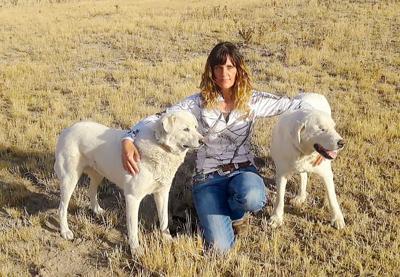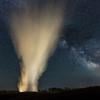TOP STORY
SAVING SHEEP DOGS: Volunteers work to find homes for Pyrenees left behind

Laurinda Nussbaum with the two Pyrenees dogs she adopted from Animals Need Help of Bear Lake in Montpelier. She and others are concerned that the sheepherding dogs are being abandoned.
Volunteers at Animals Need Help of Bear Lake, a volunteer animal rescue organization in Montpelier, say they have been trapping and rescuing Pyrenees sheepherding dogs from the mountains around the Bear Lake area for the last 15 years.
According to Lorrie Jensen, a volunteer at ANH Bear Lake, the organization has taken 34 Pyrenees dogs out of North Canyon, Bear Lake West, Eight Mile and Georgetown Canyon in just the last six years.
“One is too many,” Jensen said. “Thirty-four is a crime.”
All 34 dogs have been placed with new owners by the organization, Jensen said.
Laurinda Nussbaum of Bear Lake County adopted her first Pyrenees six years ago. Two years ago, she adopted a second, and about a year and a half ago, she became involved with the volunteer organization and has assisted in the rescue of multiple dogs.
The volunteers at ANH Bear Lake said they are not entirely certain why these dogs, which can often cost sheepherders upwards of $1,000, are being abandoned.
However, Brandy Kay, executive director of the Idaho Wool Growers Association, said she does not think the dogs are being intentionally left.
“The dogs kind of come and go a lot, so when they’re moving, I don’t think (the sheepherders) always notice a dog is missing,” Kay said.
She added that because many dogs are killed by predators on the mountains, the sheepherders could be under the impression that’s what is happening to their missing dogs.
But Jensen said she believes the dogs might be left due to the way they are trained.
According to her, in training, the dogs are often denied human contact, as it is believed that they will better protect the sheep if they are unsocialized.
Jensen said this can make the dogs wary, and it can be extremely difficult to get them off the mountain.
“I think that when it’s time to round up the sheep, if the dogs don’t come out, they leave them,” she said.
Additionally, most of the dogs are not spayed and neutered, according to Jensen, so they sometimes give birth on the mountain. She said that though most dogs they rescue are between four and seven months old, they have found newborn puppies before.
But Kay said that she believes most sheepherders do get their dogs spayed and neutered, and if the sheep dogs have puppies, the sheepherders might not know about it.
“If (the mom) is a little more elusive, she could, like any other wild dog, have a den on her own,” Kay said, “and (the sheepherders) might have no idea, honestly.”
The process of trapping and rescuing the dogs is long and arduous, Jensen and Nussbaum said, as they are often skittish and extremely wary of human contact.
Nussbaum said they have even had a team member spend the night on a mountain before to ensure the puppies they were hoping to catch were protected from coyotes.
It doesn’t get much easier once the dogs are safe at the shelter, according to Nussbaum. She said that the dogs must be fed a raw diet before slowly being introduced to dog food. Additionally, they often must put on weight before they are able to be vaccinated.
“It’s horrible,” Jensen said. “It is the most horrible situation.”
Dani Woods, a board member of ANH Bear Lake, said that she has done some research on the situation, and she believes that, as guardian dogs, Pyrenees are legally seen as livestock, and therefore enjoy fewer safeguards than family pets.
“There’s absolutely no one to speak for them and no legal protection,” Woods said.
Though federal land management agencies don’t have mandatory regulations for the use of livestock protection dogs, the American Sheep Industry Association offers a list of “recommended management practices.” These include providing adequate food and water and identification for the dogs.
Woods said she has previously tried to get into contact with some of the sheepherders, but the Forest Service does not reveal the names of those who hold grazing permits for that area.
John Carter, an ecologist who has previously worked with the Forest Service, said he has also worked to make the Forest Service aware of the issue.
“To me, the Forest Service is where the buck stops,” said Carter, who lives near Paris. “They’re the ones issuing the permits for thousands of sheep to graze up there, and they should be the ones that regulate how the dogs are treated.”
Bryan Fuell, a Forest Service ranger, said the Forest Service is aware that dogs are being found on the mountains. But he does not believe they’re being left intentionally. He added that though the Forest Service does not regulate dogs as they are not livestock, the agency is working toward finding a solution to the problem.
“When we meet with the permitees in the Spring, we are discussing with them the expectation that their animals are being removed along with the sheep,” Fuell said. “The dogs wander off, but I do agree there needs to be a level of accountability, meaning if they bring 10 dogs, they need to be able to remove 10 dogs.”
Carter and the volunteers at ANH Bear Lake have been working to improve the laws regarding sheep dogs to provide them greater protections.
Their hope is that sheep dogs will soon be required to be seen by veterinarians, spayed and neutered and tagged or microchipped.
“These people should have to have some accountability,” Jensen said. “They should have to feed them and have them altered, so there’s not puppies scattered all over the mountain.”
Nussbaum said that the problem is not unique to the area.
“This is not a Bear Lake County problem,” she said. “The Utah shelters are continually plagued with it. Wyoming has a problem as well. These are not isolated cases. It’s not a matter of if they’re going to leave a dog — it’s how many.”
An article titled “Are sheep dogs lost on the range?” published in the Post Independent, a Colorado newspaper, in 2015 said that the Rangely Animal Shelter in Colorado had rescued 16 dogs in recent years that they believed to be abandoned livestock guardians.
However, the story also quoted multiple authorities in livestock and agriculture who said that, like Kay, they seriously doubted the dogs were actually abandoned.
Janie Nafsinger, a member of the Idaho Herding Association, said she had never heard of sheepherders leaving their dogs on the mountain and didn’t know any sheepherder who would do that.
“They’re large flock guardian dogs,” Nafsinger said. “Temperament wise, they’re quite independent, and oftentimes the dog owner will leave the dog with the flock. They need these dogs to protect (the sheep) from predators.”
Kay urged anyone who sees what they believe to be an abandoned sheep dog to call the Idaho Wool Growers Association so the dog can be reunited with its owner.
“They’ll come get them,” Kay said. “They like their puppy dogs.”
However, the ANH Bear Lake volunteers, as well as Carter, still maintain that the animals are being abandoned and are in constant danger until tighter protections exist.
“I just really wish that the laws would be changed to protect these animals,” Jensen said.



